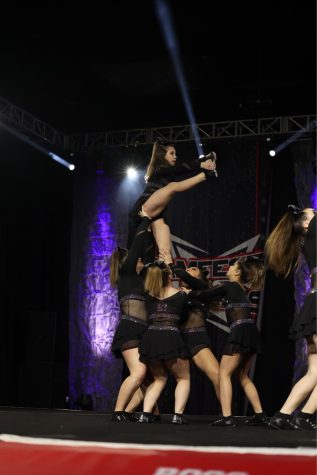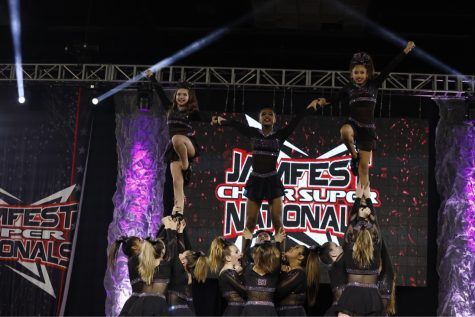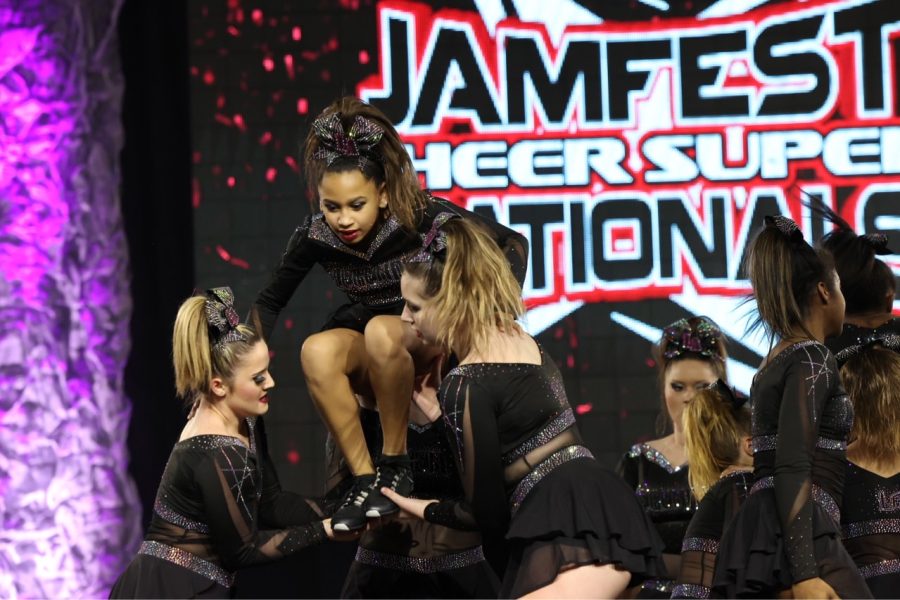Amazement of All-Star Cheerleading
February 28, 2022
Despite much controversy over the many decades, cheerleading is most definitely a sport, and an extremely athletic one at that. The addition of cheerleading to the Olympics is long overdue. Like most team sports, the broad world of cheerleading is massive. Cheerleading falls under several categories and divisions. The category that most people at Dover High School are familiar with is high school cheerleading, which for Dover involves vocal sideline cheering, tumbling and jumping, and potential statewide competitions. Most of the time though, high school cheerleading is about rooting for other sports. In the words of junior varsity sophomore cheerleader Kelsi Clay, “At Dover, we cheer for basketball and football, and we try to support our other teams as much as we can.”
Most are also aware of college cheerleading, which in itself is an entirely different category that breaks down into its own divisions: NCA and UCA. College cheerleading usually incorporates both aspects of high school cheerleading as well as more advanced stunting and pyramids and national versus solely state competitions. Each type of cheerleading is unique and different in its own way, but the branch of cheerleading that is most commonly overlooked or confused with school cheerleading is the sport of All-Star cheer.
All-Star cheerleading is so vast that it makes up an entirely different sports community than typical school cheerleading. While it is not a sport connected to schools, All-Star has so much going for each and every athlete. It allows both girls and boys not only to grow as an athlete but also as an individual. The feeling of being a part of a team and giving two hundred percent in everything that you do prepares both child and adult cheerleaders for the outside world.
Therefore, one might ask, what exactly is All-Star cheerleading? All-Star cheerleading is a form of competition cheer, but it is on a completely different side of the spectrum than high school competition cheer. All-Star cheerleading is solely based around competing, and each team has a home gym rather than a home high school. All-Star cheer gyms can have multiple different levels of teams all from the same gym. For any All-Star cheerleader, the biggest dream is for one’s team to obtain a bid to the national Summit competition in Florida, or for higher-level teams, the Cheerleading Worlds also held in Orlando each year.
All-Star cheerleading consists of little to no vocal cheer. This may sound obscure to an outsider, the fact that All-Star CHEERleaders do not actually cheer vocally at all. This is because, in All-Star, the sport is centered around solely being a team. All-Star cheerleading is all about cheering for the team itself versus showing spirit for a school district’s other sports teams.
Athletes that are a part of All-Star cheer teams have a wide variety of athletic capabilities. This is due to the fact that the sport contains intense stunting and pyramids, tumbling, sequence jumps, and a cheer dance all packed into a routine consisting of only two minutes and thirty seconds. That amount of time seems minuscule to anyone outside of the sport, but during that short amount of time, each athlete on the team must put their all on the mat and contribute everything they have for their team. Truth be told, every competition is a new chance to show the judges what potential each team has.
The sport of All-Star cheerleading is broken down into numerous different divisions, levels, and age categories. Depending on an athlete’s age, they can compete on a mini, youth, junior, senior, or international age division team. In addition, the categorization breaks down even further because each team competes at their own level and each level requires a different skillset (tumbling and stunting wise).
On All-Star teams, athletes are either bases or flyers. Bases are referred to as the athletes on the bottom of a stunt who support, toss, and catch the athlete above them, known as a flyer. Whether one is a base or flyer does not matter when it comes to which is most important for the team. Bases and flyers both have their own physical characteristics which makes them both important to the team. After all, the All-Star cheer team would cease to exist without both types of athletes on the team.
All-Star cheer competitions can range in size and location. Some competitions are local for gyms and athletes and have a smaller significance, while others require driving long distances to compete where there may be thousands of teams across a wide region competing at that exact same competition. Obviously, every competition is another checkpoint for the team, but it is also evident at times that some competitions have more of a lasting impact on the overall team’s performance for the season.
To be honest, oftentimes it can be frustrating that many people do not see All-Star cheerleading as the powerful sport that it is. Athletes on an All-Star cheerleading team commit so much time and energy into being a cheerleader that they should be recognized. For example, at my own All-Star cheerleading gym, Legends Athletics, my team, Fuchsia Fire, practices twice a week for two hours. However, the team practices do not include tumbling and stunt training, as well as conditioning time, which I use weightlifting as. In order to be the best athlete that one’s team deserves, athletes usually have to make time sacrifices in order to live up to their cheerleading potential.
On an All-Star team and quite frankly throughout the entirety of an All-Star gym, every contributor to the gym is a part of a huge family so to say. The bonds formed between fellow teammates and the bonds formed between coach and cheerleader are some that are the most long-lasting and unbreakable. At the end of the day, coaches are the people who will always be there to build the qualities of a strong team and teammates literally hold the safety of their other teammates in their own hands. In the sport of cheerleading, one wrong move can result in injury. Therefore, being on an All-Star team teaches people about trust which can be used for countless things out in the “real world.”
The All-Star cheer season usually begins in late October to early November and lasts through May-June depending on which level. The highest levels have the potential to make it all the way to the Cheerleading Worlds, while lower levels finish with Summit if they are fortunate enough to make it there with a bid. Despite which All-Star level one is on, the strength, commitment, and determination needed to be a part of such a sport are still remarkable.
All-Star cheerleading is not for everyone, but despite this, it is great that recently it is growing in popularity and recognition. The world of All-Star accepts everyone, whether female or male and should be viewed as a hardworking sport just like football or basketball and everything in between.
Being an All-Star cheerleader is not easy, and there is a reason why cheerleaders on these teams are referred to as “athletes.” It takes guts to be an All-Star cheerleader, both figuratively and literally. Each time one steps out onto the comp floor, it’s a new chance to show the fanbase of your team and the judges intently watching what your team is really made of. Each competition is a new chance to give one’s all to the sport and team that they love.
While the goal in any team sport is to be a winner, All-Star cheerleading is a sport that is not solely about bringing the shiny trophies home. Sure, any team goes out to win, but All-Star is so much more symbolic than that. In the words of one of my fellow All-Star teammates at Legends Athletics and Hoover High School freshman, Mikayla Lewis, “All-Star cheer is more than winning. It’s a SPORT that will give you life skills like determination, discipline, and even lifelong friendships. The end of your time in cheer is like a graduation.” Whether a team comes in first or last, having fun, living your best life, and loving your teammates as well as yourself is what is most important to the sport.
So, sure, All-Star cheerleading entails a lot of makeup, teased hair, and flipping across spring floors. However, the sport means so much more than what outsiders see. All-Star is all about learning to express yourself as who you really are, learning how to be a team player and love others as yourself, and learning about trust and commitment. Yes, the audience may only see two minutes and thirty seconds and a shiny trophy to take home to the shelves of the gym, but only a true All-Star cheerleader knows that the best prize isn’t what one wins at a comp. The best prize is knowing that at the end of the day, you are one with your team and one with the sport that you love. I never would have learned this without my head coach at Legends Athletics, Kameron Blatt. After all, he is the one who taught me that that’s all that truly matters.





